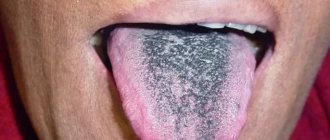The tongue has several functions in our bodies. There are thousands of taste buds on its surface, thanks to which we recognize the taste and aroma of food. But above all, it is a strong muscle with which we can speak and swallow. A healthy tongue is pink, almost smooth and elastic, and touching it should not cause pain. But if something is wrong in the body, the appearance of this muscle also changes.
What can you tell by the appearance of your tongue?
In traditional medicine, the phrase: “Show your tongue!” is usually said by a therapist and an otolaryngologist who want to examine a patient’s throat. But in Chinese traditional medicine, for more than a millennium, doctors have been diagnosing a person’s health condition by his tongue. But for maximum accuracy of diagnosis, it is recommended to examine the muscle in the morning, in good lighting, and preferably before eating and brushing your teeth.
It is interesting that even before examining the pattern on the surface of the organ, experts even pay attention to how the patient opens his mouth.
Content:
- What can you tell by the appearance of your tongue?
- Surface structure
- Color
- Plaque and possible diseases
- If your tongue hurts or burns
- What does tongue size tell you?
- What about your taste buds?
- Effect of medications on the appearance of the tongue
For example, if a person does this timidly and shows only part of his tongue, as if embarrassed, to Chinese healers this fact indicates a lack of vitality. If the patient sticks out his tongue, tilting its tip to one side, this can be perceived as a signal that there are problems on that side of the body.
According to Eastern medicine, any changes in individual parts of the organ are not an accident. The Chinese even developed a map of the relationship between individual parts of the tongue and internal organs. So, according to this theory, the language is usually divided into 5 functional zones.
Tip
This part is a “mirror” of the state of organs such as the heart and small intestine. In addition, redness on the tip of the tongue or bright spots on it may indicate anxiety or stress.
Piece by tip
By studying the state of this zone, we can draw a conclusion about the normal functioning of the respiratory and immune systems. Changes in this area may indicate bronchitis, tuberculosis, pneumonia or emphysema.
Center
The middle part of the tongue informs about the functioning of the digestive system, in particular the stomach, pancreas and spleen. Redness or yellow spots in this area indicate gastrointestinal diseases. Any changes in the central part may also be a sign of problems with stool: diarrhea or constipation.
Right and left side
These areas reflect the condition of the liver. If the sides of the tongue are swollen, this may be a signal of hepatitis or fatty liver disease. Sometimes such changes appear in people with diabetes or flatulence. Dark spots around the edges sometimes appear in the presence of cirrhosis or liver cancer.
Back (back)
Any changes in this area may indicate renal failure, bladder dysfunction, dysfunction of the gonads, or disruptions in the endocrine system. In particular, a yellow coating on the back may indicate an infectious disease of the bladder, other changes may indicate urethritis or kidney disease.
Diagnosis of diseases by tongue: forms of tongue and diseases
Deformation of the tongue can occur as a result of problems in the oral cavity. In this case, the person feels obvious discomfort in the mouth. If a person does not notice changes in the tongue, then the doctor associates the deviations with problems in the body.
By marking the tongue you can learn about the disease
- Curvature of the central stripe of the tongue indicates spinal deformity.
- Teeth marks on the sides of the tongue and on the front are formed during the process of neurosis. The disease can occur in a latent form.
- An asymmetrical shape of the tongue or a pronounced angle of inclination to one side occurs after a stroke and with improper coordination of the cerebellum.
- The convex front of the tongue reflects the inflammatory process in the respiratory organs.
- An elongated tongue with a protruding tip is a sign of weak heart function and improper blood circulation.
- Thickening of the tongue occurs due to liver failure and improper digestion.
- If, when diagnosing diseases by the tongue, tongue trembling , then you need to check the thyroid gland.
Surface structure
If cracks have formed on the surface of the tongue, this usually indicates dehydration and excessive blood thickening, which, in turn, increases the risk of stroke or thrombosis. Also, a dry surface with numerous small cracks is one of the symptoms of diabetes. But depending on their location, cracks can indicate different diseases. For example, one deep one in the middle of the tongue can be a symptom of an upset digestive system and high acidity in the stomach.
A spotted or raised tongue may indicate that a person has fungal infections, vitamin deficiency or allergies.
Sometimes such changes appear in people with vitiligo or psoriasis. But if a curved line is clearly visible on the surface, then the musculoskeletal system should be checked; this may be a signal of a spinal disease.
Treatment
The stages of plaque treatment look like this:
- Eliminating the cause.
- Relieving symptoms.
- Strengthening the body and restoring immunity.
- Compliance with preventive measures.
To remove plaque from your tongue, use folk remedies and therapy prescribed by your doctor. Do these activities at home :
- beware of nervous tension;
- keep your mouth clean;
- practice aromatherapy.
First, you need to devote enough time to hygienic maintenance of the oral cavity. Clean the plaque from the hyoid bone to the tip, covering the entire surface of the organ. To do this, use a small spatula.
You can use a brush with a special pad that has a soft texture. Treat the enamel of the teeth, and then change the position of the brush and clean the mucous membrane.
The main thing is not to overdo it, so as not to accidentally induce vomiting. Sharp objects or iron spoons should not be used. After each meal, treat your mouth with disinfectants.
Important! A large number of bacteria are collected on the back of the tongue, because this part is little active. It needs to be processed more carefully.
When removing a light film from a baby’s tongue, it is necessary to take into account his age :
- For infants, remove plaque using a piece of clean gauze;
- For a baby over 1 year old, remove plaque with a toothbrush;
- For a child over 3 years old, prepare a rinse solution.
Do not try to cure the disease yourself, so as not to worsen the problem.
Video about getting rid of plaque:
Treatment options depending on the cause of the problem
Treatment methods for white plaque can be seen in the table:
| Reason for the raid | Treatment Options |
| Taking medications | Within 1-2 days after stopping the medications, the plaque will go away on its own |
| Worms | Eliminated using medications |
| Smoking and alcoholic drinks | Requires giving up bad habits |
| Diseases in the oral cavity | Local anti-putrefactive drugs are used, oral hygiene is maintained, and junk food is required. |
| Scarlet fever | A course of antibiotic drugs from the penicillin group and rinsing with antiseptics are indicated. |
| Hypovitaminosis | The introduction of the necessary vitamins into the body is prescribed. |
| Gastrointestinal pathologies | The gastroenterologist prescribes anti-inflammatory drugs, enterosorbents, a course of vitamins and prokinetics |
| Liver failure | Treatment involves eliminating stress, drug therapy, and a strict diet. |
Typically, plaque disappears from the surface of the organ when the primary factor is eliminated.
Color
A healthy person's tongue should be slightly pink. Any changes in color can be regarded as a signal of health problems.
Crimson or violet-tinged
The tongue may acquire this color due to an excessive increase in body temperature caused by inflammation or an infectious disease. Blueness of the tongue often indicates hypoxia (impaired blood supply), and a purple tint sometimes appears after eating too spicy foods.
Scarlet
In people who have a poor diet or are obese, the middle part of the tongue may be bright red. Similar symptoms appear with gallbladder diseases or blood stagnation. If redness is visible on the tip of the tongue, this may be a sign of chronic stress, cardiac disorders, or insomnia and neuroses. If the tip of the tongue is bright red and slightly swollen, there is reason to believe that the person is suffering from coronary heart disease. Additionally, red spots on the surface may be a sign of B vitamin deficiency.
If the tongue is not just bright red, but also completely smooth, this indicates liver disease, toxin poisoning, as well as a lack of vitamin B12 and iron, since this mineral is necessary for the formation of papillae on its surface. By the way, this type of tongue can be seen in vegetarians. But if a person eats a more or less balanced diet, but his body still lacks vitamins, perhaps the reason is an autoimmune disease, due to which nutrients are not absorbed. And this can also be suspected by the unnaturally red and smooth tongue. In some cases, a smooth, very red surface may be the result of a burn or overuse of hot spices. Red spots on an unnaturally pale surface are a signal of disturbances in the respiratory system. A scarlet and grainy tongue most often indicates scarlet fever.
Very pale, almost white
Such an anomaly may indicate several serious diseases. The tongue turns pale at very low body temperatures, due to anemia, a weakened heart, or when the immune system is impaired.
Black
A very dark, almost black tongue always indicates kidney dysfunction. In addition, it does not matter in which particular zone the dark spots appeared, although most often in such cases the base of the tongue turns black.
White spots on the mucous membrane
Sometimes painless white spots may form on the tongue (bottom or along the edges). Medically they are known as leukoplakia. They are formed as a result of excessive cell growth. Smokers often have such spots. And in this case, this is a very alarming signal. Leukoplakia is called a precancerous condition. Between 5 and 17% of people with these spots eventually develop cancer. However, if you quit smoking in time, the spots will disappear. If such spots appear in non-smokers, then perhaps their cause is banal rubbing of the tongue by the teeth. But if leukoplakia does not go away, you should consult a dentist to solve the problem.
Plaque and possible diseases
During normal functioning of the body, the human tongue is covered with a thin, loose layer of whitish plaque. If it changes color or thickness, this is already an alarming signal.
White
A dense white coating can appear as a result of hypothermia or a slowdown in metabolism (this often happens in the fall). If the plaque is uniform, but very thick, this indicates the presence of a bacterial infection in the body, and if it forms lumps, this is a signal of a fungal disease.
A thick layer of white plaque also occurs with chronic gastritis with high acidity or enterocolitis. With gastritis with low acidity, the plaque is not as thick and drier. It is also interesting that by the thick white coating on the tongue you can recognize those with a sweet tooth and lovers of dairy products.
Grey
Gray plaque is a sign of infectious diseases accompanied by fever. Also, a grayish coating may indicate diseases of the gastrointestinal tract or liver. In particular, the tongue may acquire a grayish tint during an exacerbation of peptic ulcer disease. If a gray coating appears in the company of small blisters on the tongue, the person may be suffering from herpes. A grayish coating can also signal that the body lacks iron.
Brown
Most often, a tongue with a dense brown coating can be seen in smokers. The same symptom indicates disturbances in the respiratory system, which can lead to hypoxia. Also, brown plaque is a signal of digestive problems.
Yellow
If such a plaque appears in a person in the summer, this may indicate overheating of the body. The surface of the tongue also turns yellow after drinking coffee or certain spices. In more serious cases, the appearance of yellow plaque indicates a gastric ulcer, malfunction of the pancreas or liver.
Greenish
Plaque with a green tint is a very alarming signal. As a rule, it warns of serious liver diseases, including the development of cancer.
Prevention of plaque on the tongue
Prevention of plaque on the tongue is non-specific and fits into the rules of daily hygienic oral care:
- Daily brushing of teeth – 2 times a day (morning and evening);
- Using dental floss after meals and mouthwashes;
- Regular visits to the dentist - at least 2 times a year for a preventive examination;
- Timely treatment of digestive problems and pathologies of internal organs.
Have you found a coating on your tongue and don’t know how to get rid of it? Make an appointment with our specialist and he will provide the necessary assistance!
If your tongue hurts or burns
In many cases, painful sensations in the tongue appear as a result of not following a balanced diet. In particular, pain can occur due to a lack of iron, vitamins B6, B3 (PP) and B12.
A burning sensation on the surface of the muscle may indicate that the stomach is producing too few digestive juices, so this symptom usually indicates a malfunction of the gastrointestinal tract.
Sometimes, if the tongue looks no different, but there is a burning sensation, this may indicate a hormonal imbalance. By the way, women experience this symptom almost 7 times more often than men. In addition, the burning sensation may be the result of an allergy to the wrong toothpaste.
Diagnosis of diseases by tongue: signs of oral diseases
The tongue changes shape and color not only with pathologies of the body. If there is an inflammatory process in the mouth, a number of characteristic symptoms appear on the tongue:
- swelling and redness;
- copious amounts of saliva;
- decreased quality of taste - with prolonged loss of taste, consultation with an endocrinologist and neurologist is required;
- discomfort on the tongue when eating;
- pain due to the inflamed surface of the tongue.
Diagnosis of health based on the state of the tongue
Complications with the tongue often occur due to long-term use of medications. In particular, after taking antibiotics. With drug intoxication, cracks and characteristic itching appear on the tongue. When diagnosing diseases by language, symptoms appear both individually and in combination.
What does tongue size tell you?
If we carry out diagnostics based on the appearance of the tongue, then experts also advise paying attention to its size. If it is excessively large and swollen (touches the corners of the mouth), you should check for problems with the heart, thyroid gland, spleen, kidneys.
The tongue increases in size with anemia, allergies, or if for some other reason the whole body swells in a person, as well as in people who are overly nervous. Swollen veins under the tip of the muscle may indicate heart failure.
If the tongue is smaller than normal size, then it is quite possible that the body is suffering from a deficiency of vitamins and minerals, and this may also be a symptom of a very weakened immune system.
How to identify a disease by the color of your tongue
When making a diagnosis, they rely on a set of signs:
- tongue color in diseases;
- the form of this body;
- oral odor;
- plaque, its color and quantity;
- work of taste buds;
- degree of language functioning.
Another criterion is a change in certain areas of a given organ. But this criterion is very individual and rare. Scientists have hypothesized that the tongue is divided into sections, and each section is associated with a specific organ.
If you need to determine whether the body is healthy or there is some kind of disease, you should examine the tongue only early in the morning on an empty stomach, and rinse your mouth with water before examination. It is best to carry out the inspection in a well-lit room.
What about your taste buds?
On the surface of the tongue there are thousands of small pimples - these are papillae. All of them can be divided into 6 groups, each of which plays its own role, including the ability to distinguish four basic tastes: sweet, salty, bitter and sour.
Interestingly, over time, taste buds “wear out,” but if a person is healthy, they are replaced by new “pimples.” At a young age, this process occurs quite quickly, and after 45 years, as a rule, it slows down.
Best materials of the month
- Coronaviruses: SARS-CoV-2 (COVID-19)
- Antibiotics for the prevention and treatment of COVID-19: how effective are they?
- The most common "office" diseases
- Does vodka kill coronavirus?
- How to stay alive on our roads?
Therefore, with age, a person ceases to distinguish tastes and aromas so keenly. But sometimes the inability to taste food is not just due to age. Loss of sensitivity in taste buds may be a symptom of a bacterial infection in the digestive tract or indicate problems with the pancreas.









